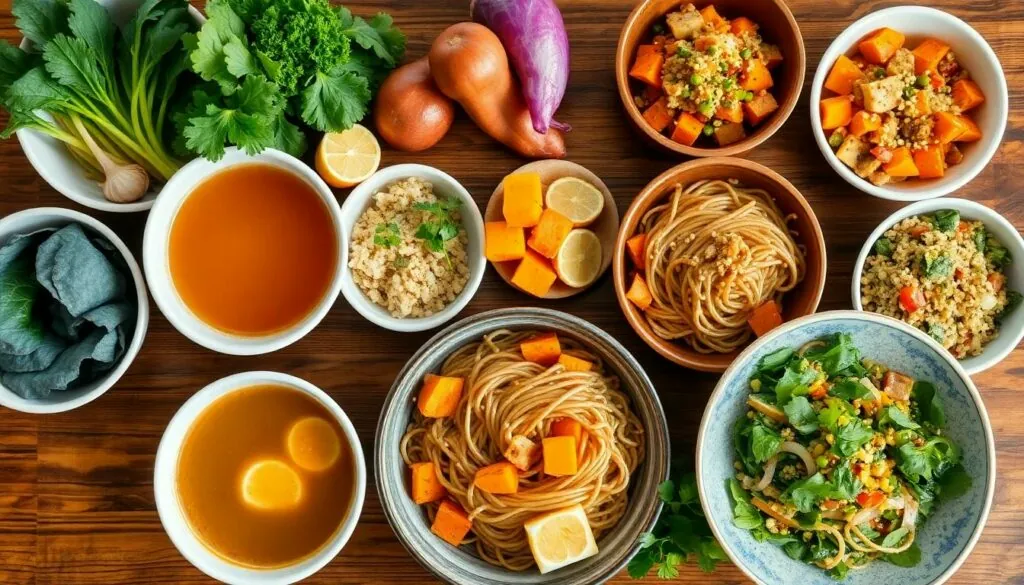Table of Contents
ToggleImagine sinking your teeth into a delicious meal that not only tantalizes your taste buds but also promises longevity and vitality. Welcome to the Okinawa diet, where fresh ingredients and vibrant flavors come together to create culinary magic. This diet, inspired by the island known for its centenarians, emphasizes whole foods, plant-based ingredients, and a sprinkle of joy in every bite.
What Is the Okinawa Diet?
The Okinawa diet emphasizes fresh, whole foods and plant-based ingredients. This approach not only creates flavorful meals but also contributes to health and longevity.
Origins and Principles
Okinawa’s dietary roots trace back to the island’s unique culture and environment. Traditional meals include vegetables, legumes, and fish, reflecting local agriculture. Low caloric intake combined with high nutrient density defines its principles. Inhabitants traditionally focus on moderation, often adhering to the 80% rule, meaning they stop eating when 80% full. Seasonal ingredients play a critical role, ensuring meals are both fresh and diverse. This diet celebrates food variety and community, promoting shared meals that enhance social bonds.
Nutritional Benefits
The Okinawa diet offers numerous nutritional advantages. High levels of antioxidants found in vegetables support overall health. Rich in omega-3 fatty acids from fish, it contributes to heart health and brain function. This diet encourages the consumption of complex carbohydrates, which provide sustainable energy. Fiber-rich foods help with digestion and maintain a healthy weight. Studies link adherence to the Okinawa diet with lower risks of chronic diseases, including heart disease and cancer, underscoring its effectiveness for longevity and well-being.
Key Ingredients in Okinawa Diet Recipes

Okinawa diet recipes feature a variety of key ingredients that enhance flavor and support health.
Vegetables and Legumes
Leafy greens, such as spinach and kale, dominate Okinawa meals. Other staples include sweet potatoes, a rich source of vitamins and fiber, alongside daikon radish and carrots. Beans, particularly soybeans, provide protein and essential nutrients. The variety ensures a balanced intake of antioxidants and phytonutrients, crucial for overall well-being.
Fishes and Seafoods
Okinawa cuisine highlights fish, especially fatty varieties like mackerel and sardines. These fish deliver omega-3 fatty acids, known for their anti-inflammatory properties. Seaweeds also play a significant role, offering minerals and vitamins, thus enhancing the nutritional profile of dishes. Regular consumption of these ingredients supports both heart health and cognitive function.
Whole Grains and Healthy Fats
Brown rice serves as a foundational grain, providing complex carbohydrates and fiber. Whole grains promote sustained energy throughout the day. Incorporation of healthy fats from sources like avocados and olive oil contributes to heart health and flavor. These fats assist in nutrient absorption and help maintain optimal energy levels.
Popular Okinawa Diet Recipes
The Okinawa diet offers a wealth of flavorful and nutritious recipes. These dishes celebrate the vibrant ingredients found on the island, creating meals that nourish the body and soul.
Traditional Dishes
Traditional Okinawa dishes feature fresh vegetables, legumes, and fish. Goya champuru stands out as a signature stir-fry made with bitter melon, tofu, and pork, providing a unique balance of flavors. Okinawa soba, a noodle soup, highlights wheat noodles topped with pork and green onions, embodying comfort and satisfaction. Sweet potato (imo) remains a staple, often enjoyed boiled or roasted, delivering natural sweetness and fiber. Another popular dish is miso soup, offering umami flavors with ingredients like seaweed, tofu, and seasonal vegetables. Each dish reflects the island’s rich culinary heritage and commitment to health.
Modern Adaptations
Modern adaptations of Okinawa recipes blend traditional elements with contemporary cooking styles. Quinoa salad with goya and fresh herbs enhances nutritional value while maintaining the original flavors. Zucchini noodles replace wheat noodles in a lighter version of Okinawa soba, catering to health-conscious diners. Plant-based proteins often substitute meat, drawing on beans and legumes for added nutrients. Smoothies featuring sweet potato and spinach provide convenient, on-the-go nutrition. These innovative dishes promote the essential principles of the Okinawa diet while appealing to a wider audience, ensuring the legacy of these recipes continues.
Cooking Tips for Okinawa Diet Recipes
Cooking Okinawa diet recipes involves embracing fresh ingredients and mindful techniques that enhance flavor and nutrition. Knowledge of these methods ensures delicious and healthful meals.
Preparation Techniques
Utilizing simple preparation techniques is key to preserving the nutrients in ingredients. Steaming vegetables helps retain vitamins and minerals. Boiling sweet potatoes and root vegetables increases their natural sweetness while keeping their rich nutrients intact. Another effective method is stir-frying, which quickly cooks ingredients like greens and tofu, allowing flavors to meld while minimizing nutrient loss. Preparing dishes in bulk and freezing portions can also save time and ensure access to healthy meals. Applying these techniques maintains the integrity of ingredients, aligning with the principles of the Okinawa diet.
Flavor Enhancements
Incorporating fresh herbs and spices enhances the natural flavors of Okinawa diet recipes. Ginger and garlic bring depth to dishes while providing health benefits. Adding lime or lemon juice brightens flavors and adds a refreshing tang. Miso paste offers umami richness, which can elevate soups and marinades. Seaweed not only strengthens flavors but also infuses dishes with important minerals. Utilizing high-quality oils, like sesame or olive, enhances taste and supports heart health. These enhancements ensure every meal is vibrant and satisfying, true to the spirit of the Okinawa diet.
Embracing the Okinawa diet offers a pathway to vibrant health and longevity. By focusing on fresh, whole foods and plant-based ingredients, individuals can enjoy delicious meals while reaping numerous health benefits. The blend of traditional recipes and modern adaptations ensures that anyone can incorporate these nutritious principles into their daily lives.
The emphasis on seasonal ingredients and mindful cooking techniques not only enhances flavor but also supports overall well-being. As more people discover the joys of Okinawa diet recipes, they’ll find that this approach to eating fosters a deeper connection to food and community. With each meal, it’s possible to celebrate health, flavor, and the rich culinary heritage of Okinawa.




